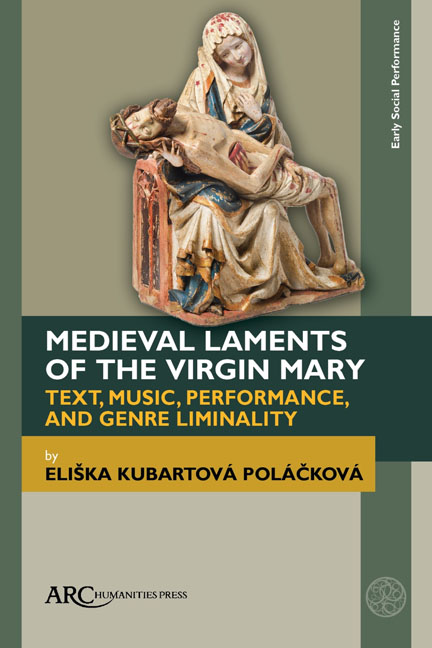Book contents
- Frontmatter
- Contents
- List of Illustrations
- Preface
- Introduction. The Suffering of the Virgin Mary as an Inner Drama
- Chapter One Marian Lament and Medieval Piety
- Chapter Two Genre, Mediality and Aesthetics
- Chapter Three Modes of Performance
- Chapter Four Bohemian Laments: Feeling Like a Woman, Thinking Like a Man. Or Not?
- Appendix: Bohemian Marian Laments — Excerpts
- Bibliography
- Index
Chapter One - Marian Lament and Medieval Piety
Published online by Cambridge University Press: 28 December 2023
- Frontmatter
- Contents
- List of Illustrations
- Preface
- Introduction. The Suffering of the Virgin Mary as an Inner Drama
- Chapter One Marian Lament and Medieval Piety
- Chapter Two Genre, Mediality and Aesthetics
- Chapter Three Modes of Performance
- Chapter Four Bohemian Laments: Feeling Like a Woman, Thinking Like a Man. Or Not?
- Appendix: Bohemian Marian Laments — Excerpts
- Bibliography
- Index
Summary
FROM THE EARLY Christian period up to the later Middle Ages, the Virgin Mary is an omnipresent figure in medieval religious practise and culture. From her withdrawn, hieratic representation as the Queen of Heaven in late Antiquity and the first centuries of the medieval era, Mary would gradually grow closer to the terrestrial experience of her devotees, firstly of the religious women and men in monastic communities, and later, from the thirteenth century onwards, also of the lay believers. To all of them, Mary increasingly appeared not only as a graceful Regina Coeli, but also as a loving, caring, and suffering Mother of God. The various images of Mary reached medieval Christians by way of different cultural media through which veneration of the Virgin was expressed and experienced. Marian liturgies, prayers, hymns, sermons, sculptures, relics, Books of Hours, and other textual, visual, and performative media, all contributed to the establishment of the various faces of Mary as a virgin, bride of God, mother of the Saviour, second to Christ in salvation history, Porta Coeli, a gateway to heaven through whose advocacy devotees could approach the Lord with their prayers without fear of rejection. Part of this Marian imagery was also her rendition as Mater Dolorosa, a mother desperately lamenting the death of her son on the cross, as represented in various types of Marian Lament.
As indicated earlier, the planctus Mariae was one element of this all-encompassing Marian veneration, occurring in the paraliturgical context as part of the Easter celebration during the Paschal Triduum; as part of the Passion plays performed during the longer period of time from the Holy Week to the end of the Easter octave; as part of the individual and collective acts of piety carried out by members of convents and other religious communities, and equally by devoted individuals such as anchorites, recluses, and well-off aristocratic women and men who did not belong to any organized group, cultivating their spirituality in their courtly and urban homes or in the solitude of their anchorages. Marian Lament was interwoven in the complex web of various devotional practises and idioms related to the Virgin Mary and her Son, most importantly the com-passionate devotion to the Passion discussed in the previous chapter, and the eucharistic devotion closely related to it.
- Type
- Chapter
- Information
- Medieval Laments of the Virgin MaryText, Music, Performance, and Genre Liminality, pp. 29 - 74Publisher: Amsterdam University PressPrint publication year: 2023

